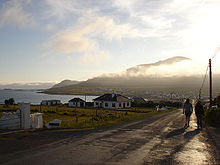- Dooagh
-
Dooagh (Irish: Dumha Acha) is a village located on Achill Island in County Mayo, Ireland. It is best known for the nearby Keem Bay, a Blue Flag beach.
Contents
Facilities
Although not full of amenities like its neighbour Keel, Dooagh has an air of beauty, where life is slow and relaxed. It once had three hotels but these have been closed due to the falling level of tourism in recent times. There are, however, many Bed and breakfast establishments and self-catering apartments. There are two Public houses, "The Pub" or "Lourdies," and Gielty's, which also have Traditional Irish Music sessions. There is also a post office and grocery store, and CheckPoint Press, a publishing and author services operation, is based in Dooagh.
Places of interest
- Going west along the road leads you over the side of Croghaun Mountain to the golden sands of Keem Strand, with impressive views over Clew Bay. A turning off the Keem Road leads to Lough Acorrymore, surrounded by scree slopes and now dammed to supply water for the entire island[1]. The seaward side of Croghaun has spectacularly high cliffs, the island's highest.
- On the road from Dooagh beach towards Lough Acorrymore stands an impressive building called Corrymore House, once the home of Captain Charles Boycott[1], a British land agent whose ostracism by his local community in Ireland as part of a campaign for agrarian tenants' rights in 1880 gave the English language the verb to boycott, meaning "to ostracise". Captain Boycott moved to Corrymore House after his residence at Keem was burnt down. The American artist Robert Henri also lived there at one time[1], having bought the house in 1924[2].
Culture
- A proud tradition of the Pipe band thrives on Achill, with the Island having five Pipe bands, Dooagh Pipe Band being one of these. Dooagh Pipe Band was founded on 17 March 1947 with a membership of eleven[3]. With over 50 members it is now the Island's largest band.
- Scoil Acla, Irish Traditional Music Summer School, takes place annually in Dooagh. In 2008 300 students enrolled. Scoil Acla was established in 1910. Artist Paul Henry was an active member of Scoil Acla and in 1912 directed the play Casadh an t-Sugain (The Twisting Of The Rope) by Douglas Hyde, in the Scoil Acla Hall. The school gradually went into decline, but was revived again in 1985[4].
Education
- Dooagh National School serves the family's of the Dooagh, Pollagh and Keel areas. It has 63 pupils and three teachers. The school was built in 1959 and renovated in 2001[5].
- Achill Archaeological Field School is based at the Achill Archaeology Centre in Dooagh. It was founded in 1991 and is a training school for students of archaeology and anthropology. Since 1991, several thousand students from 21 countries have come to Achill to study. The school is involved in a study of the prehistoric and historic landscape at Slievemore, incorporating a research excavation at a number of sites within the Deserted Village of Slievemore. Slievemore is rich in archaeological monuments that span a 5000 year period from the Neolithic to the Post Medieval[6].
People
- In the centre of Dooagh is a commemoration plaque to Don Allum, the first man to row across the Atlantic Ocean in both directions. He landed close to the memorial on Dooagh beach on 4 September 1987, completing the second leg of his voyage[7].
- Artist Robert Henri came to Achill on a regular basis in the early decades of the 20th century. It was during his early trips to Achill prior to the outbreak of World War I that Henri painted extensively and is reputed to have done portraits of almost all the children in Dooagh village. He bought Corrymore House on the hill above Dooagh in 1924. He died in America in 1929[2].
- Novelist Graham Greene, visited and stayed on Achill Island a number of times in the late 1940s. He wrote parts of the novels The Heart of the Matter (subsequently banned in Ireland) and The Fallen Idol in Dooagh, and Achill Island is also said to have inspired Greene to write some of his best poetry. He retained a special affection for Achill Island, which he mentioned frequently in his letters and notes, although this was likely due in some part to the circumstances of his visits, as he was introduced to Achill by his mistress, Catherine Walston. She rented a cottage in Dooagh, with no electricity, one outside tap for water, and a corrugated iron roof on the traditional stone cottage, now since demolished[8].
References
- ^ a b c "Dooagh" (PDF). Achill Tourism. http://www.achilltourism.com/dwl/achill-walk-B.pdf. Retrieved 7 March 2009.
- ^ a b "Their portraits are famous in America but - Whatever happened to the Commins family of Achill?". Western People - 1 April 1998. http://archives.tcm.ie/westernpeople/1998/04/01/News.htm. Retrieved 7 March 2009.
- ^ "Dooagh Pipe Band". band website. http://www.dooagh.com/. Retrieved 7 March 2009.
- ^ "Scoil Acla Irish Traditional Music Summer School". Scoil Acla. http://www.scoilacla.com/index.htm. Retrieved 7 March 2009.
- ^ "Dooagh National School". School website. http://www.dumhach.com/. Retrieved 7 March 2009.
- ^ "Achill Archaeological Field School 2009". Achill Archaeological Field School. http://www.achill-fieldschool.com/. Retrieved 7 March 2009.
- ^ "Don Allum". Doc Brown.info. http://www.docbrown.info/docspics/irishviews/ivpage115.htm. Retrieved 7 March 2009.
- ^ "Graham Greene & Achill Island". Achill 24/7. http://www.achill247.com/writers/ggreene.html. Retrieved 7 March 2009.
External links
Categories:- Villages in Achill Island
Wikimedia Foundation. 2010.


